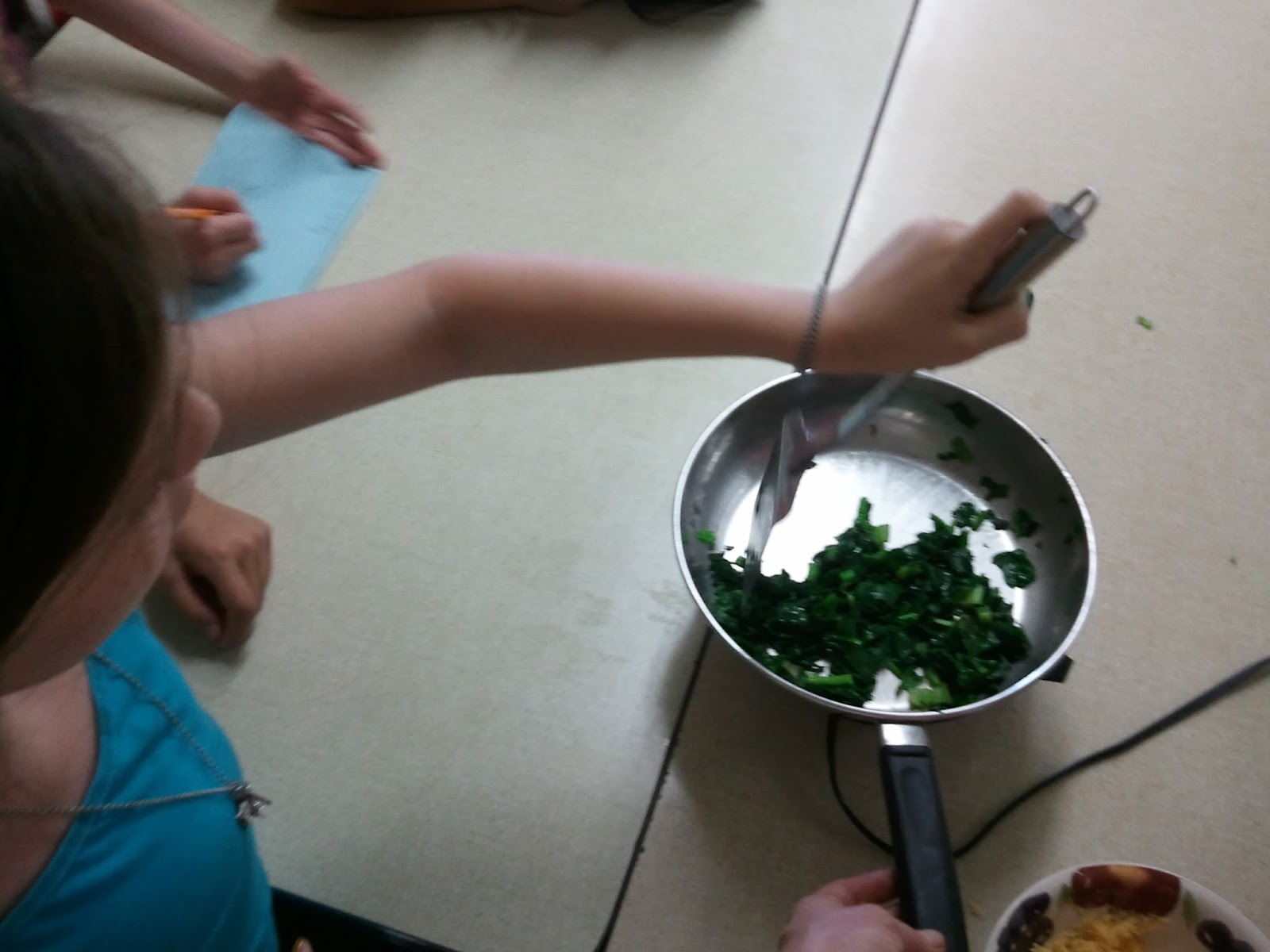There are many fun ways to incorporate Using the Harvest
into lessons plans, and cooking is always a popular and exiting activity for
students. It can turn them on to new taste combinations, and since the
students are doing all the harvesting, measuring, chopping, and cooking
themselves, they are gaining ownership and experience.
One girl, after we made a Plant Part Stir Fry, asked if I
knew what she was having her mom make for dinner. When I asked her what it was,
she said dramatically, while pointing to her plate “This!”
For my last session, we made a stir fry using
every vegetable available in the garden, a simple teriyaki sauce, and mixed in
quinoa to create bulk since the greens cooked down so much. When I asked what
they thought about it, one boy said it was “revolutionary”, and another
followed saying it was like “two revolutionary wars collided into each other
creating a non-stop taste explosion that rocked my tongue and mouth to heaven”
and then said “It was delicious. I don’t know who taught you how to cook, but
they did a really good job.” It was an awesome way to end the year.
Cooking is an easy place to incorporate math, inquiry, and
technology and science- figuring out conversions, doing taste tests and
comparing ingredients, and looking up information on the internet for recipes,
ingredients, locating farms that local produce could come from, and composting
scraps and plants after harvest.
I always brought copies of the recipe to send home, or if it was something we were putting together as we went along, had the students write the recipe out. What I learned though
experience is that there is always a time crunch when cooking, so rather than having each student
writing their own recipe card during the cooking session, it is better to have
one white board or clipboard where you, or the students, can write out
measurements and ingredients as you go and the students can make their recipe card at a later time.
I was lucky to have access to the staff kitchen, so we did
get to use an oven for some of our cooking activities. I also had a single
burner that I would set up on a table for any other cooking so everyone could
see and take turns adding ingredients and stirring.
It is helpful to have a volunteer and at least two stations-
we would often have a chopping station and measuring station.
I learned it is best to have an adult distribute toppings and condiments (salt, dressing, syrup, ketchup, seeds, etc) a little at a time, since it is easy to
overdo it with those.
Here is what we did this year:
Plant Part Salad: When we were learning about plant parts,
we finished our session with a Plant Part Salad, including roots, stems,
leaves, flowers, fruits, and seeds. You can use what you have in the garden and
bring some extra produce to fill in. We harvested kale, chard, lettuce (leaves),
and tomatoes (fruit) from the garden. I brought carrot (root), celery (stem),
broccoli (flower), plain sunflower seeds and spicy pumpkin seeds. Before we
started making the salad I explained we were making a Plant Part Salad, held up
each ingredient, and had the students say what plant part it was. We also made
a homemade ranch dressing that everyone took turns measuring into a jar and
passed around to shake.
Another group made a Plant Part Stir Fry and made quinoa to
use as the seed.
In the fall we made Apple Muffins, and while they were baking
did a blind taste test of five different apple varieties, many of which were
heirloom and donated by a local organic farm. This was a great way to emphasize
the difference in taste between varieties of the same thing, so if the students
try something they don’t like in the garden, to remember it might be the
variety, not the vegetable. It was also another demonstration of difference in
taste buds and preference, and reminder of why it’s so important to have good
tasting etiquette.
 |
| Peeling the Apples |
We used pumpkin to make Pumpkin Pancakes and roasted pumpkin
seeds. A few students helped me scoop the seeds out of the pumpkin on their
break. I baked the pumpkin, let it cool, and everyone scooped out flesh from
their individual piece for the pancakes. We toasted the seeds while we were
making the pancake batter. Making the batter was a fun time for mental math,
using division so everyone could measure a portion of the ingredients.
This spring we made a veggie scramble, which was incredibly
delicious, harvesting greens and garlic tips from the garden, and adding eggs,
cheese and milk. I put as much milk as I thought we would need in a jar and had
the students measure it out in teaspoons and tablespoons and use conversions to
find the total amount (3 teaspoons in a tablespoon, 4 tablespoons in ¼ cup,
etc) We took all usable leaves off the giant, overgrown chard plant and then
pulled it out for the compost.
 |
| Team Effort Composting |
 |
| Constructing Potato Towers |
 |
| Testing out Recipes |
 |
| Garden Salad |
We also made many salads or vegetable wraps right in the
garden. We discussed recipes and proportions and students loved trying out
different combinations to see what they liked best.
 |
| Flower Power! |






No comments:
Post a Comment